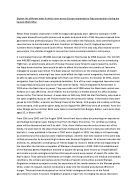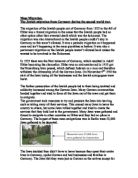From 12th June 1942 until 1st August 1944, Anne Frank kept a diary documenting her experience and feelings during her years hiding in fear from the Nazis. She writes, ‘I'm terrified our hiding place will be discovered and we’ll be shot’. Otto, Anne’s father was the only survivor out of the family, he went back to the place they had been hiding and found Anne’s diary was still where she had left it, it was published in German in 1947 and in English in 1952. Her diary is still read today as a testimony to the way Jews were treated by Nazis. Another man who reacted in the same way to Nazi persecution by documenting his abuse was Emanuel Ringleblum. As a former historian and archivist, he, along with a small group of friends began to record in detail what was happening to the Jews after the German occupation of Warsaw in September in 1939. With the establishment of the Warsaw ghetto Ringleblum decided to expand the group (now known as ‘Oneg Shabbat’) and create a secret underground archive that would record every aspect of Jewish life under the Nazi’s abuse. They collected information on hunger, the living conditions, the medical and sanitary conditions, the schools and camps and on the fate of Jewish communities outside Warsaw. Ringleblum initiated a project to study the experience of the Jewish women in the Warsaw ghetto while, under his request, doctors conducted a study into the medical and physical effects of hunger. These archives were passed on to the Polish underground then on to the Polish government-in-exile in London. Ringleblum played a major role in bringing the abuse Jews were suffering to the outside world. This remarkable man was also partially responsible for the planning of the Warsaw Ghetto Uprising in 1942.
The use of armed resistance was the most forceful and violent reaction to the Nazi persecution with over 100 ghettos in Poland and the Soviet Union using this method. These rebellions were organised by Jewish prisoners at 3 of the 6 extermination camps- Treblinka, Sobibor and Auschwitz- Birkenau. In October 1943 a load of Jews had just arrived at Auschwitz- Birkenau from Bergen- Belsen and were getting undressed in Crematorium 2 a woman grabbed a pistol from a SS officer and shot 2 guards, one of which died in hospital following the shooting. Other woman joined in however all the women were killed as a result. Following this, on the 7th of October 1944, 250 Sonderkommando Jews were involved in an uprising setting a crematorium on fire killing 3 SS officers and injuring 10 but still in spite of their efforts, all 250 Jews involved were killed. All the uprises held were eventually put down however these attempts were not in vain as some Jews did manage to escape during the chaos.
Viewed as the most controversial action of the Jews during the holocaust, the Judenrἄte were established in German occupied eastern European to implement German policies and maintain order in the ghettos. The first one was established by decree on September 21st 1939, a mere 3 weeks after the invasion of Poland. The Judenrἄte was made up of 12-24 Jewish men and it was thought the idea behind it was to maintain communities destined for annihilation of the Jewish people by providing for the needs of the Jewish people living in the ghettos such as sanitation, education and food. Some meetings held between the Nazis and the Judenrἄte seemed genuinely ‘friendly’ and courteous whereas others were harsh and threatening. The Nazis made demand and the Jews followed those demands in promise of supplies and relief for the inhabitants of the ghettos. However Jews were angry at the members of the Judenrἄte for enforcing the German’s decrees and conditions. The ultimate defining test of courage however was when the Germans forced the Judenrἄte to choose people from their ghetto to be deported. Everyone knew that deportation meant being transferred from their current ghetto to an extermination camp to be killed. The hardest decision that had to be made for many was that of how many children and older people to send away to be killed. Some members of Judenrἄte felt this demand had to be met so as to continue receiving supplies for their ghettos. Rumkowski said ‘I must cut off the limbs to save the body’ whereas some felt this demand was just too extreme like Czerniakow, who committed suicide so he would not have to make the decision of who in his community he was going to be responsible for their death. In her book, ‘Eichmann’, Hannah Arendt revived controversy claiming that the Jews collaboration caused for a higher death rate.
However despite the Jews attempts to escape persecution and to fight back against the Nazis, between 5 and million Jews were persecuted between 1941 and 1945 in Europe. Still, their efforts were not in vain as 3 million managed to escape. Of all the courses taken by the Jews in reaction to persecution, emigration proved most effective whereas armed resistance, the most violent approach, was the least successful.








